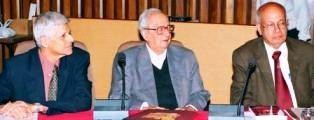The Indian government, which abandoned cold fusion research 16 years ago, is now being advised by its top scientists to revive it.
The recommendation stems from a meeting of a galaxy of leading nuclear physicists, metallurgists and electrochemists at the National Institute of Advanced Studies held in Bangalore on January 9.
"We did great injustice to the country by stopping the research that was going on at the Bhabha Atomic Research Centre BARC)," Padmanabha Krishnagopala Iyengar, considered the father of cold fusion in India, told Nature India . Iyengar, former director of BARC, who could not attend the meeting, said on phone that India had lost out 15 years by this wrong move but even now "it is not too late to revive it."
Fusion trio at the meet: (from left) M.Srinivasan, B.V. Sreekantan, S.Ranganathan. Credit: NIAS
"This is the first time in India that industry is showing interest in an area whose commercial value is yet to be proven," said Mahadeva Srinivasan, formerly associate director of physics at BARC in Mumbai, and the key scientist behind the move.
Nuclear fusion that powers the sun occurs under extreme temperature and pressure in which nuclei of hydrogen or its heavier cousins deuterium and tritium fuse to release energy. Achieving fusion at room temperature was widely believed to be impossible until March 23, 1989 when Martin Fleischmann and Stanley Pons at the University of Utah in the United States startled the world with their tabletop experiment.
They connected a battery to a pair of palladium electrodes immersed in a jar of water containing deuterium and showed their electrolytic cell produced heat energy in excess of what was consumed. They claimed that origin of the energy was nuclear and that deuterium nuclei were being packed into the palladium's molecular lattice in such a way for fusion to take place.
Later it became apparent from other groups and pioneering experiments by Srinivasan and Iyengar at BARC in early 1990s that the reaction produced tritium as well as helium indicating that cold fusion was real. However further work at BARC was stopped in the light of lack of consensus among mainstream physicists globally and denunciation of cold fusion by the US government.
"The long neglect of this area (of research) by India must end now," Malur Ramaswamy Srinivasan, former secretary to the Department of Atomic Energy (DAE), told the meeting "to take stock of the status of the field with an open mind."
"Over the years there is greater understanding (about LENR) and we have people who can take the research forward," he said. "It is an interesting field with potential benefits and the DAE should set apart money for restarting the work."
"The fact that cold fusion has not been disproved 19 years after its discovery and that 200 scientists in 13 nations are working on it is sufficient reason for India to get into action again," Valangiman Ramamurthy, a nuclear physicist and former science secretary to the government told Nature India .
Krishna Raghavendra Rao, a nuclear physicist and associate editor of Current Science , asked, "If India can spend millions on the international "hot" fusion project ITER, why not a few thousands for cold fusion?"
With big names in Indian science pushing for it, laboratories like the Central Electrochemical Research Institute in Karaikudi that aborted their cold fusion work in the 1990s are hoping to pull it out of the deep freeze.
Srinivasan said the Indian Institute of Technology in Chennai has agreed to initiate research in LENR as have BARC and Indira Gandhi Centre for Atomic Research near Chennai. He said much of the credit for reviving cold fusion work in India should go to Michael McKubre, director of energy research centre at SRI International in California, a pioneer in cold fusion research and a participant at the Bangalore meeting.
According to McKubre, so far around 2000 papers on cold fusion have been published including in 55 peer reviewed journals and 13 international conferences have been held on the subject. Studies have confirmed excess energy production as much as 50 times the input, he said, adding that an experiment in his lab continuously generated energy for over three weeks.
"One reason I am here is to help form an LENR group in India and invite that group to join our consortium," McKubre told Nature India .
Besides SRI International, the consortium presently has Massachusetts Institute of Technology and Naval Research Laboratory of the United States, ENEA Frasati of Italy and Energetics Technologies of Israel as its members.
"The field is going to move forward rapidly," McKubre said. "India is a refreshing place to do research, has competent people who, unlike in the US, have no reluctance to enter this controversial field."
